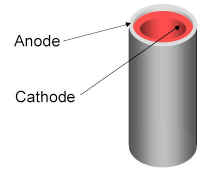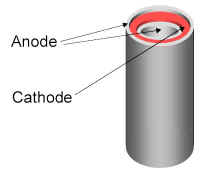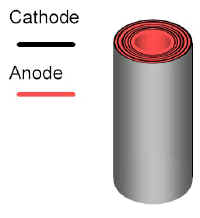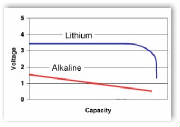Oilfield customers specify a particular cell for their battery
pack/modules after considering cell characteristics: Chemistry
- Lithium vs. Alkaline Lithium Lithium batteries are very attractive
to the oil industry due to a combination of high energy density, high voltage, high current capability, wide temperature range,
long shelf life, and stable operating voltage. Lithium Thionyl Chloride and Lithium Sulfuryl Chloride cells are also
known as liquid cathode lithium cells. All lithium cells and batteries made with cells larger
than an AA size are restricted to being transported on Cargo Aircraft Only. An exception to this is when a cell manufacturer
performs testing certifying that the cell is non-dangerous as per United Nations guidelines. Although
there are many variations of lithium cells, the following 3 types are most commonly used in the oil patch.
Lithium
Thionyl Chloride (Li/SOCL2) Probably the most commonly used type, lithium/thionyl
chloride cells have one the highest energy densities of available battery systems. All of our suppliers manufacture
this type, and a variation of this system is available with maximum temperature ratings of 180oC and 200oC. | Lithium Thionyl Chloride | | | Open Circuit Voltage | 3.67 V | | Nominal
Voltage | 3.4 V | | Discharge Profile | Flat | | Available Temp. Rating | 85°C, 150oC, 180oC and 200oC |
Lithium Sulfuryl Chloride (Li/SO2CL2) Although
similar, this type is different from Lithium/Thionyl Chloride cells in the following ways: - higher energy density due to higher voltage
- increased current
capability due to higher conductivity of electrodes
A variation
of this system is available with a maximum temperature rating of 165oC.
| Lithium/Sulfuryl Chloride | | | Open Circuit Voltage | 3.9 V | | Nominal Voltage | 3.5 V | | Discharge
Profile | Flat | | Max. Avail. Temp. Rating | 150oC
and 165oC |
Alkaline
(Zn/alkaline/MnO2) Because of its low maximum temperature rating
(93oC), alkaline cells have limited use in the oil patch. However, in cooler applications, alkaline cells
are an excellent choice due to their low cost, high power output, safety, and no restrictions in transportation. | Alkaline | | | Open Circuit Voltage | 1.5 V | | Nominal Voltage | 1.2
V | | Discharge Profile | Sloping | | Max. Avail. Temp. Rating | 93oC |
Energy Density Comparison
A comparison of Energy Density for different primary battery chemistries. This is an approximation
due to manufacturer's differences in the methods used to collect this data
Current Capability
All of the lithium cell manufacturers utilize 3 basic types of construction: Bobbin, Moderate Rate,
and Spiral. The cell construction determines the amount of common surface area between the anode (lithium) and the cathode
(high surface area carbon cathode). The amount of electrode surface area is proportional to the current capability of
the cell. Bobbin This type has a small common surface area between the anode and the cathode. Basically
it consists of one cylinder of cathode surrounded by one cylinder of anode material. The low common surface area results
in low rate discharge capability. The advantages of this type of cell are its low manufacturing cost, low self discharge
rate, and no safety fuse requirement. These cells' limited current capability and the resulting effect of
passivation may limit their use in high current applications.
Moderate Rate Similar to the Bobbin style, the moderate rate, otherwise known as dual or double
anode, incorporates another layer of anode material in the center of the cathode. Although manufacturers' assembly
techniques vary, the goal with this type of construction is to increase the common surface area between the electrodes so
that the cell has a higher current capability than a bobbin cell. Like a bobbin cell, this type does not generally need
a safety fuse.
Spiral Also
known as jelly roll construction, spiral cells have a very large common surface area  between the anode and the cathode; thus the current capability of these cells is very high. Although high rate cells
require safety fuses, they are able to produce enough current to satisfy most downhole tool requirements without the effects
of passivation. between the anode and the cathode; thus the current capability of these cells is very high. Although high rate cells
require safety fuses, they are able to produce enough current to satisfy most downhole tool requirements without the effects
of passivation. * VERY IMPORTANT * Some spiral cells are case positive and some are case negative. Caution is required when wiring
into a series string not to mix polarity.
Temperature Rating
Manufacturers use various methods to design a cell chemistry in order to operate at a particular maximum temperature.
It is recommended that users specify the lowest temperature rated cell that can be safely used. This is because
higher temperature cells tend to be more expensive, and they have some performance drawbacks if the cells are used at low
temperatures.
Under no circumstances should a user attempt to use a cell in an environment exceeding the temperature
rating of the cell.
Voltage
Keep in mind that the operating voltage is lower than open circuit voltage. Lithium cells, depending
on the load and chemistry, have an operating voltage ranging from 2.5 - 3.9 volts. Alkaline cells operate between 0.8
- 1.6 volts. While alkaline cells' voltage decreases over the length of discharge,
lithium cells maintain a steady voltage until near the end of discharge.
Assembling
cells in series: the voltage multiplies by the number of cells.
Assembling
cells in parallel: the current capability and capacity multiplies by the number of cells in parallel.

| Chemistry | Voltage | | Lithium/Thionyl Chloride | 3.6
V | | Lithium/Sulfuryl Chloride | 3.9 V | | Alkaline | 1.5 V |
Resistance to Shock and Vibration
Spectrum Batteries has cells available in all sizes that are capable of withstanding
the high shock and vibration typically encountered in downhole drilling conditions. For more information on
the proper cell selection for applications in these harsh environments, please contact us at info@spectrumbatteries.com.
Dimensions
Cells available
from Spectrum Batteries are optimally sized for downhole tools. Our cell suppliers have developed special sized
C, CC, and DD cells to fit in these demanding applications. The Spectrum Batteries alkaline cell is slightly smaller
than most commercially available alkaline cells making it optimally sized for bottom hole pressure surveys
|

